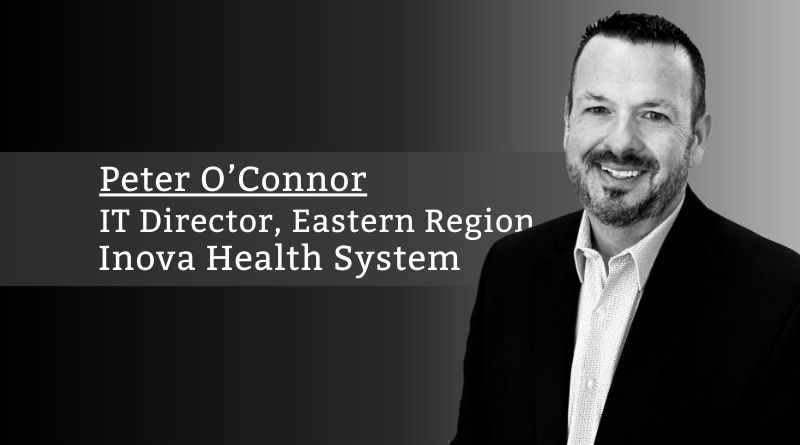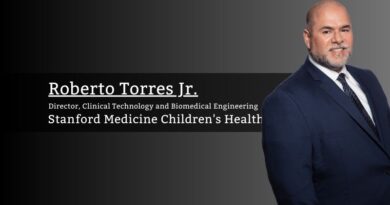“Getting Out of Your Comfort Zone” – IT’s Role in Surgical Technology
By Peter O’Connor, IT Director, Eastern Region, Inova Health System
The surgical environment is a beautiful collage of talented human hands, rigorous clinical processes, delicate tools, sophisticated medical devices, and technology that push and pull critical information to a wide variety of places with countless integrations. Where does “traditional IT” start and stop in this incredibly complex environment? The answer is traditional IT is fluid throughout the surgical environment.
I have been envisioning, planning, and designing technology for hospitals with a specialty in perioperative spaces for over 30 years. I currently serve as IT Director, Eastern Region at Inova, a health system in Northern Virginia. I am planning the technology infrastructure for near-term renovations and two new state-of-the-art campuses opening in early 2028. These projects include General and Hybrid ORs, Interventional labs, Cath labs, and EP labs. This article will help you navigate through the design, planning and implementation of a complex environment. Stepping out of the traditional IT role, one must immerse themselves into the perioperative world, bridging the gap between clinical processes, biomed systems, IT systems, and infrastructure.
Becoming Fluent
Experts say that the best way to learn a foreign language is to immerse yourself in the environment, culture, and community to fully understand not only the language, but also the nuances of the language. The approach to understanding perioperative spaces is very similar. The key to understanding the needs of the perioperative environment is to spend time in the OR, observe various case types, and interview people in different roles to better understand their unique technology needs.
Stepping out of the traditional IT role, one must immerse themselves into the perioperative world, bridging the gap between clinical processes, biomed systems, IT systems, and infrastructure.
Pebbles in Your Shoes
The current OR environment is riddled with technological challenges, many of which are a result of missing design elements, incompatible products, and equipment added as an afterthought. Common challenges and themes include:
- Poor cable management: Often, this is the result of not fully understanding all the equipment required for a surgical case, where it will be located (cart or boom), and how that equipment is connected to infrastructure (data and video) and the patient. Poor cable management results in tripping hazards, broken cables, and unexpected disconnects during a procedure.
- Poor visualization of video images and data: This is a result of not understanding where certain surgical team members work in the room and the ability of visualizing key points of the procedure.
- Intraoperative issues and Inefficient workflows: Disparate systems and equipment that do not easily share data.
Space Planning & Design
In order to address the issues above, one must understand that healthcare IT is constantly evolving and the traditional lines of delineation between medical equipment and IT systems are virtually non-existent. The days of medical equipment connecting to and communicating over isolated or dedicated networks are gone. Planning for a ubiquitous medical-grade infrastructure while ensuring the foundational requirements, including cyber security, redundancy, business continuity, and performance is critical.
- Space Planning: Traditionally, IT conversations occur after architects have designed the room. To effectively plan ORs for current and future technology needs, technology must be included at the very beginning with a multi-disciplinary approach. This would include clinical teams (surgeon, nursing, anesthesia, surgical techs), architects, MEP-IT engineers, IT, and clinical (biomed) engineering). Technology elements that impact room design include:
- Wall monitor placement (based on sightlines)
- Equipment/anesthesia boom placement (impacts workflow, connectivity)
- Identification of what equipment resides on the equipment boom and what equipment is brought into the field (impacts connectivity)
- In-field monitor booms quantity and size (impacts ceiling congestion and sightlines)
- PC placement for physician, anesthesiologist, and circulator (impacts workstation mounting and connectivity)
- Surgical robot consoles (space and connectivity impact)
- Immovable equipment such as OR video integration rack (hard to find locations for room-specific fixed equipment)
- Control room layout, number of seats, equipment placement (screens and CPUs)
The best way to visualize and discover the pros and cons of device placement is to create a full-scale mock-up of the OR. 3D modeling software and Virtual Reality are extremely helpful and can save a tremendous amount of time, but if a full-scale temporary mock-up is an option, it would be the preference.
- Pathways and Connectivity: Once the equipment has been located, cable pathways should be identified. In the OR, cabling transcends traditional structured cabling topology (data wall plate) wired to the “data closet”, as many system cable routes are point-to-point. The challenge is that these point-to-point requirements are typically not “designed” by anyone on the design team. Larger fixed imaging equipment vendors will provide site-specific drawings, but the smaller fixed systems, often found in EP, Cath, Hybrid, and IR rooms, will not provide site-specific designs. The cable and conduit requirements for these systems are typically found in the back of an installation guide (in the form of single-line diagrams) and must be interpreted for each specific room layout. This task is typically missed on most projects and only discovered during the equipment installation, resulting in the costly addition of point-to-point conduit and cabling in a room that is finished from a construction perspective.
- Data Sharing: A significant challenge in the healthcare IT is the lack of native interoperability and data sharing from system to system. Something as simple as loading patient and case information into the various systems in the OR may require multiple steps and/or manual entry. A key requirement for the planning and design of these spaces is outlining the data workflow from preparing a case, pulling reference images, documenting a case, saving case images, and any post-case review/image processing.
The role of IT and the participation of IT in the planning and design of a procedural space in the perioperative world requires us to get out of our comfort zone, becoming fluent in both the clinical and technical aspects of these wonderfully complex spaces as well as learning the design and appropriate application of medical devices and systems that we traditionally do not encounter.



